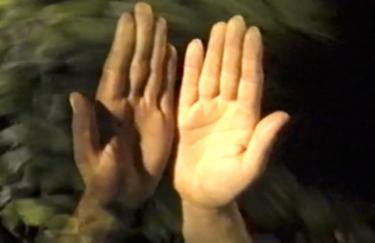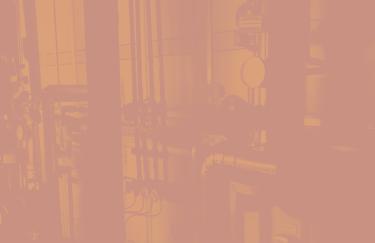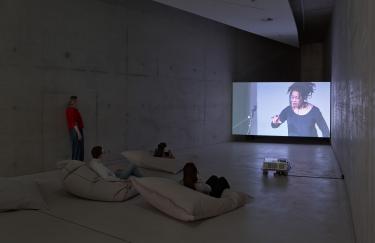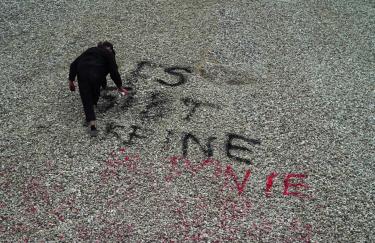
Do Videos Dream of Glitching?
When we immerse ourselves in digital worlds, we count on their seamless functioning. The website will load instantly, the video call won’t lag ... but that’s not always the case. By disrupting their flow, distortions produce alternative spaces and modes of understanding. The errors, malfunctions, disruptions that lead to irritation in our everyday lives—mostly just annoying, but sometimes surprising—are also called glitches.
A glitch can be intentional or occasional. It celebrates the inefficient, the irrational, the annoying disruption. It often shows illusionistic traits reminiscent of phantasmagoria, a term borrowed from stage magic and the history of technology. Therefore, it has been employed by a variety of artists as an aesthetic and conceptual tool. We argue that some video artists use glitching as an emancipatory strategy that enables a deeper critique of technology. We argue that phantasmagoric video glitches reveal hidden (power) structures within technology, media and politics that reach beyond their technological mechanics.
The works we selected for this screening question the boundary between malfunction and manipulation. Where does illusion collide with dysfunction? What if we lived in a phantasmagoric reality and could only dream of glitches that help us escape to what's beyond the illusion?
Steina Vasulka (b. 1940 in Reykjavik, IS, lives and works in Santa Fe, US) and Woody Vasulka (b. 1937 in Brno, CZ, d. 2019 in Santa Fe, US) are husband-and-wife pioneers of video art. As early as the 1960s they were producing works in which they experimented with electronic signals. Noisefields is an important example of formal and technological experiments with analog video, in which the boundaries between video and new media blur. Electronic signals were visualized here and resemble a flicker effect. Different colors and the pulsating between a circular form and its outer surfaces produce a hypnotic effect.
In her study of psychology Franziska Megert (b. 1950 in Thun, CH, lives and works in Bern, CH, and Düsseldorf, DE) employs the video and still camera for documentation purposes. Her artistic work is marked by her interest in visualizing the human physiognomy. Her works have an experimental character that is also reflected in Sweet Dressing. The abstract forms in constant motion suggest the silhouettes of two people, a woman and a man. Gradually they become visible from the contours of their clothing.
Paul Garrin (b. 1957 in Philadelphia, US, lives and works in New York City, US) has often used the medium of video to document and expose institutionalized violence and oppression, for example, by the police. Free Society is an electronic collage that depicts military glory and brutality. Images of parading police and military units are contrasted with themes addressed worldwide such as the political situation in South Africa, the West Bank, South Korea, North Ireland, and Panama as well as the “Civil Rights Riots” of the 1960s in Alabama, in Chicago in 1968, and in New York in 1988.
Raphael Montañez Ortíz (b. 1934 Brooklyn, US, lives and works in Highland Park, US) is a Nuyorican (New Yorker from the Puerto Rican diaspora) artist and founder of the El Museo del Barrio in New York. He achieved international fame with his “Destructivism: A Manifesto” and the works that resulted from it. In Busy Bodies, as in many of his other videos, the artist appropriates scenes from old Hollywood productions by breaking them down, superimposing over them, taking very brief sequences, and reproducing them again and again with slight variations. The dialogue of the two old women whose faces are placed over the scene like masks was taken from the film Gone with the Wind (1939).
Ulrike Rosenbach (b. 1943 in Bad Salzdetfurth, DE, lives and works in Bad Münstereifel, DE) was one of the first and is one of the best-known video artists. Since the 1970s she has used her works in support of feminist causes. The video Das Feenband (The Fairy Tape) shows a shimmering surface that is slowly set in motion like a visual gong or a mirror moon. The video reflects images from the fog. It suggests memories imbedded in landscapes of mountains and lakes—as if from a family album. The artist’s face appears between them, as if in a dialogue.
George Barber (b. 1958 near Georgetown, GY, lives and works in London, UK) is eclectic and his ideas diverse. Narratives and found footage are at the center of many of his works, which he either deconstructs or transforms such that they contradict their author’s original intention. In his videos elements of television are inverted, modeled, and reinterpreted. Effervescence combines a kind of nonlinear, psychedelic “dark ambient” visual game with interactive technology and takes us on a journey to the edge of new forms.
Norbert Meissner (b. 1954 in Stendal, DE, lives and works in Leipzig, DE) has been engaged in the distribution of and education about video art in Germany since the mid-1980s. Meissner was a founding member of the Fernseh Akademie Mitteldeutschland and since 1990s has been chairman of the board of the pirate television station Kanal X. Dialog is an analog video work, realized with what was then highly advanced videotape technology. The video represents a structural analysis of the electronic image with semantic and political undertones. Image and sound form disruptive elements and thematize the historical relationship between East and West. Russian and American sound-media materials are mixed and allude to structures of political communication, as does the work’s ironic-sounding title.
Exhibition venue
Videolounge der Stiftung IMAI im
NRW-Forum Düsseldorf
Ehrenhof 2
40479 Düsseldorf










